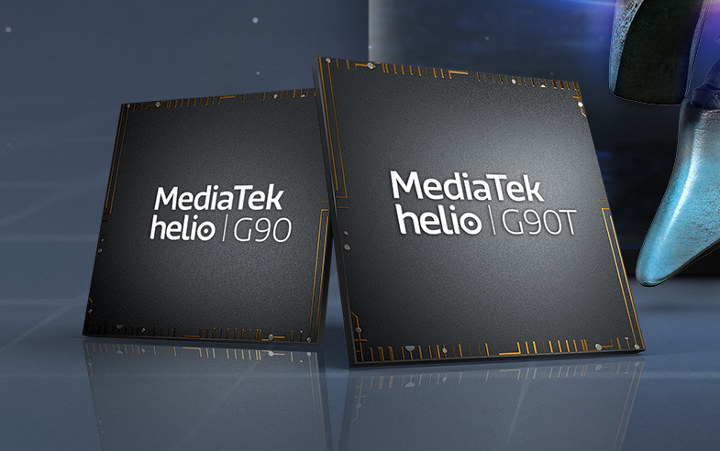We’ve known MediaTek P-series for mid-range “premium” smartphones, and MediaTek X-Series for higher-performance mobile devices for a few years, but the company is now introducing G-series processors specifically designed for mobile gaming starting with MediaTek Helio G90 and G90T processors.
Both feature eight Arm Cortex-A76/Cortex-A55 cores clocked at up to 2.05GHz coupled with an Arm Mali-G76 3EEMC4 with speeds up to 800MHz, as well as “HyperEngine Game Technology”, an umbrella name covering multiple features we’ll cover further below.
MediaTek Helio G90T specifications:
- CPU – Arm Cortex-A76 plus Cortex-A55 octa-core up to 2.05GHz “with a large L3 cache”
- GPU – Arm Mali-G76 3EEMC4 with speeds up to 800MHz
- AI Acceleration – Up to 1TMACs AI Performance
- Memory – LPDDR3, LPDDR4x up to 2133MHz, 10GB RAM max
- Storage – eMMC 5.1, UFS 2.1
- Display – Up to 2520 x 1080
- Video
- Encoding – H.264, H.265 / HEVC @ 4K 30fps, FHD 120fps, HD 240fps
- Playback – H.264, H.265 / HEVC, VP-9 @ 4K 30fps, FHD 120fps, HD 240fps
- Connectivity
- Cellular
- Technologies – Carrier Aggregation (CA), CDMA2000 1x/EVDO Rev. A (SRLTE), FDD / TDD LTE, HSPA+
- Specific Functions – 4X4 MIMO, 3XCA, 256QAM, TAS 2.0, HPUE, IMS (VoLTE\ViLTE\WoWi-Fi), eMBMS, Dual 4G VoLTE (DSDS), Band 71
- LTE Category – Cat-12 DL / Cat-13 UL
- GNSS – Beidou, Galileo, Glonass, GPS
- Wi-Fi – Wi-Fi 5 (802.11 a/b/g/n/ac)
- Bluetooth 5.0
- FM Radio
- Cellular
- Camera
- ISP – 24MP+16MP, 48MP, 64MP
- Capture FPS – 64MP @ 22.5fps, 48MP @ 30fps; 24MP + 16MP @ 30fps
- Features – 3X ISP; AI Face Detection; HW depth engine; AINR; Single-Cam/Dual-Cam Bokeh; Hardware Warping Engine (EIS); Rolling Shutter Compensation (RSC) engine; MEMA 3DNR; Multi-Frame Noise reduction;
- Misc – CorePilot, NeuroPilot, Pump Express, Tiny Sensor Hub
- Process – 12nm FinFET
MediaTek did not think it would be useful to provide details about the differences between G90 and G90T, but all numbers above are for Helio G90T, so I’d expect it to be the fastest device, and Helio G90 CPU and GPU are likely clocked lower.
Back to the “HyperEngine Game Technology”. Here’s what if offers according to the press release:
- Networking Engine – If it detects the Wi-Fi signal degrading, it triggers Wi-Fi and LTE concurrency that takes just milliseconds, and keeps the network connection smooth and the game lag-free.
- Dual Wi-Fi Connections – Allows a single smartphone antenna to be connected to two Wi-Fi bands (2.4GHz/5GHz) or two routers simultaneously. It could just be RSDB (Real Simulatenous Dual Band).
- Call & Data Concurrency – When your smartphone receives a call it won’t drop the data connection, and you can defer a call without leaving the game.
- Rapid Response Engine – Uses touch acceleration to improve in-game action-to-display speeds so the game world is streamed and rendered fast and fluidly.
- Resource Management Engine – Intelligently directs device resources including CPU and GPU for optimum performance and automatically delivers smooth, fluid, high-performance frame rates in games.
- Picture Quality Engine – Supports the latest HDR10 standard with 10-bit color depth on HDR-enabled smartphone displays
MediaTek Helio G90 & G90T processors are said to be ideal for top titles such as Fornite, PUBG, or KOG.
MediaTek did not provide any details about the timing of commercial availability of end devices powered by MediaTek Helio G90/G90T processor. More details can be found in the product page.

Jean-Luc started CNX Software in 2010 as a part-time endeavor, before quitting his job as a software engineering manager, and starting to write daily news, and reviews full time later in 2011.
Support CNX Software! Donate via cryptocurrencies, become a Patron on Patreon, or purchase goods on Amazon or Aliexpress





